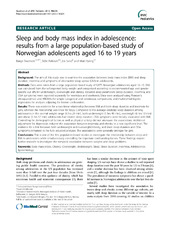| dc.contributor.author | Sivertsen, Børge | |
| dc.contributor.author | Pallesen, Ståle | |
| dc.contributor.author | Sand, Liv | |
| dc.contributor.author | Hysing, Mari | |
| dc.date.accessioned | 2015-10-06T08:23:55Z | |
| dc.date.available | 2015-10-06T08:23:55Z | |
| dc.date.issued | 2014-08-15 | |
| dc.Published | BMC Pediatrics 2014, 14:204 | eng |
| dc.identifier.issn | 1471-2431 | |
| dc.identifier.uri | https://hdl.handle.net/1956/10546 | |
| dc.description.abstract | Background: The aim of this study was to examine the association between body mass index (BMI) and sleep duration, insomnia and symptoms of obstructive sleep apnea (OSA) in adolescents. Methods: Data were taken from a large population based study of 9,875 Norwegian adolescents aged 16–19. BMI was calculated from the self-reported body weight and categorized according to recommended age and gender specific cut offs for underweight, overweight and obesity. Detailed sleep parameters (sleep duration, insomnia, and OSA symptoms) were reported separately for weekdays and weekends. Data were analyzed using Pearson’s chi-squared test and ANOVAs for simple categorical and continuous comparisons, and multinomial logistic regressions for analyses adjusting for known confounders. Results: There was evidence for a curvilinear relationship between BMI and both sleep duration and insomnia for girls, whereas the relationship was linear for boys. Compared to the average weekday sleep duration among adolescents in the normal weight range (6 hrs 29 min), both underweight (5 hrs 48 min), overweight (6 hrs 13 min) and obese (5 hrs 57 min) adolescents had shorter sleep duration. OSA symptoms were linearly associated with BMI. Controlling for demographical factors as well as physical activity did not attenuate the associations. Additional adjustment for depression reduced the association between insomnia and obesity to a non-significant level. The evidence for a link between both underweight and overweight/obesity, and short sleep duration and OSA symptoms remained in the fully adjusted analyses. The associations were generally stronger for girls. Conclusions: This is one of the first population-based studies to investigate the relationship between sleep and BMI in adolescents while simultaneously controlling for important confounding factors. These findings require further research to investigate the temporal association between weights and sleep problems. | en_US |
| dc.language.iso | eng | eng |
| dc.publisher | BioMed Central | eng |
| dc.relation.uri | http://www.biomedcentral.com/content/pdf/1471-2431-14-204.pdf | |
| dc.rights | Attribution CC BY | eng |
| dc.rights.uri | http://creativecommons.org/licenses/by/4.0 | eng |
| dc.subject | Body mass index | eng |
| dc.subject | Obesity | eng |
| dc.subject | Overweight | eng |
| dc.subject | Underweight | eng |
| dc.subject | Sleep | eng |
| dc.subject | Sleep duration | eng |
| dc.subject | Insomnia | eng |
| dc.subject | Adolescence | eng |
| dc.subject | Epidemiology | eng |
| dc.title | Sleep and body mass index in adolescence: results from a large population-based study of Norwegian adolescents aged 16 to 19 years | eng |
| dc.type | Peer reviewed | |
| dc.type | Journal article | |
| dc.date.updated | 2015-07-28T11:14:57Z | |
| dc.description.version | publishedVersion | |
| dc.rights.holder | Copyright 2014 The Authors | eng |
| dc.identifier.doi | https://doi.org/10.1186/1471-2431-14-204 | |
| dc.identifier.cristin | 1153399 | |
| dc.subject.nsi | VDP::Medisinske fag: 700::Helsefag: 800::Epidemiologi medisinsk og odontologisk statistikk: 803 | |
| dc.subject.nsi | VDP::Midical sciences: 700::Health sciences: 800::Epidemiology, medical and dental statistics: 803 | |

